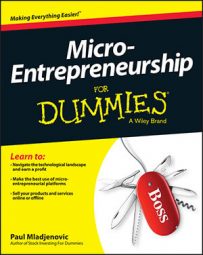SEO (search engine optimization) can improve awareness of your micro-entrepreneurial business by making it easier for potential customers to search for and find your business website, blog, Facebook page, and so on. To optimize your website using SEO, you need to understand how SEO works.
After you set up your website or blog, you want to make sure people can find you when they’re searching for a service or product that’s in line with what you offer.
To improve the findability of your site, you select the right keywords to use and increase the number of links that point to your site. You can also use listing services and the search engines themselves to get listed.
Use keywords to improve the SEO of your micro-entrepreneurial site
When people search for a product or service, they will type keywords in their favorite search engine. Keywords are the search terms (such as words or phrases) that people will enter in their search efforts.
Take the time and find out what people search for because it will definitely pay off for you. You can adjust your site(s) so that your prospective customers can more easily find you. One way to analyze the keywords you want to use is to use the Google’s Webmaster’s Toolbox.
You can make sure that your keywords are present in the following ways to increase the chances of your prospects finding you:
Meta tags: Meta tags are keywords that are embedded in the coding of web pages. They’re technically not the same as keywords that are in the visible text of the web page. Your web page designer or your web page software can place meta tag words of your choice in the coding.
Many search engines use meta tags in their search criteria. You can actually view the meta tags when you use the “View Source” feature in your browser software (such as Internet Explorer) and even edit the words (only do it if you’re familiar with web page creation and design).
Headlines: Make sure your page headings (and/or subheadings) have keywords.
In your content: Make sure you have keywords strategically placed throughout your content.
Domain name: Keywords in the domain name itself are helpful toward your SEO efforts.
Images: Even images can be keyword optimized. Make sure that the image file name has keywords as well. For example, if your site has a picture of an umbrella and you want people to find it when they do a search for “umbrella,” then make sure the image file name is “umbrella.jpg” or “umbrella.gif” depending on the image file format.
Making your website and/or blog easy to be found on search engines (getting them optimized) is certainly a priority, but you also want to keep in mind that any presence you post on any site (even if the site isn’t your own) will help you to be found. Here are some other forms of web presence that you should optimize:
Your articles: If you write articles and get them published on article database sites, such as Ezine Articles, optimize them. Make sure that you have enough keywords strategically placed in your content.
Blog posts: If you’re writing posts for others (such as when you do guest blogging), remember those keywords so that you are easily found. If your prospective customers find you in the blog post (and, of course, you have a link to your site), then it boosts your marketing.
Your video channel: People can easily find videos on YouTube and other video sites on the major search engines, so make sure that your videos and your video channel have the appropriate keywords in the title, description, and so on.
Try to include keywords in your content naturally, but don’t overdo it because doing so can harm your site. The search engines will drop you like a hot potato if you employ practices such as keyword stuffing, where you find devious ways to add lots of keywords in an attempt to elevate your site’s exposure with the search engines and get your site ranked higher.
Add links to your site or blog to increase SEO
Another aspect of SEO is getting more links aimed at your site or blog. A link (also called hyperlink or hypertext) is specially coded text that users can click on to navigate to the web page or element of a web page associated with that link’s code.
A site that has 100 other sites linking to it (called back links because they link back to the desired web page or site) will have much more success than a site that has no other sites linking to it (all things being equal). Search engines that detect with their technology that more and more other sites are linking to you will rank you higher.
Even if several back links don’t get you ranked higher on search engines, you still want lots of back links because the cumulative effects of those back links mean more traffic for your site.
Increasing links back to your page doesn’t automatically happen. A website needs to make it happen. Either you can contact other websites to exchange links (“you link to me and I link to you”), or you can get various services that can perform this function for you.
There are ample strategies for either approach (most will try to do both approaches). To find out more about linking strategies, check out these resources:

